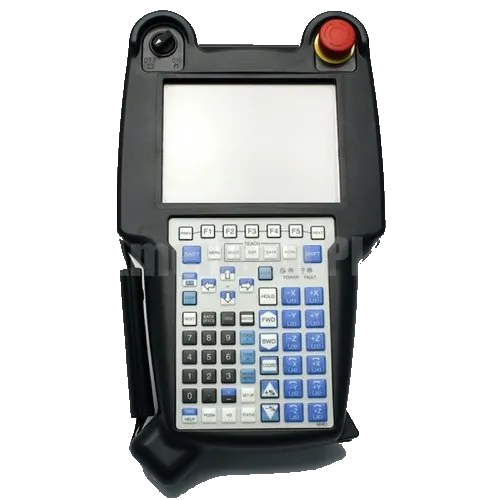Fanuc Programming
Home > Fanuc > Programming
Programming a Fanuc Robot
Utilizing a Fanuc robot necessitates programming, an endeavor made approachable by the system’s intuitive interfaces. Comparatively, the programming language employed by Fanuc robots is less intricate than that of some other brands, such as ABB robots.
Teach Pendant
Programming a FANUC robot via the Teach Pendant involves a user-friendly, step-by-step process. This handheld device, equipped with a screen and buttons, provides a direct means for operators to input commands into the robot’s control system. Fanuc leverages these Teach Pendants as accessible interfaces for programming and controlling their industrial robots.

Roboguide
An advanced approach to programming a FANUC robot involves the utilization of RoboGuide—a sophisticated simulation software that facilitates the development, simulation, and testing of robotic applications within a virtual environment. RoboGuide, designed by FANUC, acts as a robust platform streamlining the programming process by allowing comprehensive design and optimization of robotic tasks before their execution in the real world.
The process within RoboGuide commences with creating a virtual environment that replicates the real-world setting. This digital workspace enables users to model the robot, its peripherals, and the surrounding environment. Through RoboGuide’s intuitive interface, programmers input intricate specifications like the robot’s kinematics, end-of-arm tooling, and workpiece models.
Programming in RoboGuide entails using its graphical user interface to generate robot programs. Rather than manually teaching the robot, operators employ a programming language—often FANUC’s proprietary language (KAREL or TP)—to script the robot’s actions. This approach offers precise control over the robot’s movements, interactions, and decision-making processes.
RoboGuide provides an array of tools aiding programmers in developing complex action sequences. These tools encompass pre-defined commands, motion planning utilities, and simulation features enabling visualization and fine-tuning of the robot’s behavior. Its 3D simulation capabilities empower operators to validate programmed tasks, detect potential errors, and optimize robot trajectories and cycle times.
Additionally, RoboGuide facilitates risk-free testing and verification of robot programs within a virtual environment. Simulation scenarios assess collision detection, feasibility, and efficiency of programmed sequences without risking equipment or personnel.
Upon satisfactory simulated performance, validated tasks transfer seamlessly from RoboGuide to the physical FANUC robot controller. This ensures accurate and efficient execution, minimizing downtime, and enhancing productivity during implementation.
Soure: Fanuc